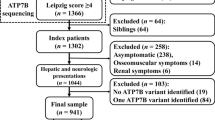Abstract
Wilson disease (WD) is the most common disorder resulting in hepatic copper overload. A similar form of copper-associated cirrhosis caused by mutations of the canine copper toxicosis MURR1 gene is also observed in Bedlington terriers. Recent studies indicate that MURR1 might influence human copper metabolism and the clinical presentations of WD. However, the correlation between the MURR1 gene and the Chinese patients with WD has not been reported. In the present study, all three exons of the MURR1 gene including the intron–exon boundaries were directly sequenced in 120 unrelated healthy Chinese and 218 unrelated Chinese patients with WD. No mutations were detected in coding and splice site sequence in the human MURR1 gene. A novel polymorphism 3′+119T→A in the 3′ untranslated region (UTR) was identified in three healthy individuals and four patients with two disease-causing mutations in the ATP7B gene and a great diversity of clinical presentations. Of the ATP7B mutations reported here, Gly1268Arg is a novel one. Also, the previously described nucleotide change IVS2+63C→G was detected in 31.66% of normal chromosomes and 26.15% of WD chromosomes. The results have indicated that there is no correlation between MURR1 and WD in the Chinese population.

Similar content being viewed by others
References
Danks DM (1995) Disorders of copper transport. In: Scriver CR, Beaudet AL, Sly WS, Valle D (eds) The metabolic basis of inherited disease. McGraw-Hill, New York, pp 2211–2235
Brewer GJ (1998) Wilson disease and canine copper toxicosis. Am J Clin Nutr 67(Suppl):1087–1090
Bull PC, Thomas GR, Rommens JM, Forbes JR, Cox DW (1993) The Wilson disease is a putative copper transporting P-type ATPase similar to the Menkes gene. Nat Genet 5:327–335
Tanzi RE, Petrukhin K, Chernov I, Pellequer JL, Wasco W, Ross B et al (1993) The Wilson disease gene is a copper transporting ATPase with homology to the Menkes disease gene. Nat Genet 5:344–350
Kenney S, Cox DW. Wilson disease mutation database. http://www.medgen.med.ualberta.ca/database.html
Thomas GR, Forbes JR, Roberts EA, Walshe JM, Cox DW (1995) The Wilson disease gene: spectrum of mutations and their consequences. Nat Genet 9:210–217
Figus A, Angius A, Loudianos G, Bertini C, Dessi V, Loi A et al (1995) Molecular pathology and haplotype analysis of Wilson disease in Mediterranean population. Am J Hum Genet 57:1318–1324
Shah AB, Chernov I, Zhang HT, Ross BM, Das K, Lutsenko S et al (1997) Identification and analysis of mutations in the Wilson disease gene (ATP7B): population frequencies, genotype–phenotype correlation, and functional analyses. Am J Hum Genet 61:317–328
Kalinsky H, Funes A, Zeldin A, pel-Or Y, Korostishevsky M, Gershoni-Baruch R et al (1998) Novel ATP7B mutation causing Wilson disease in several Israeli ethnic groups. Hum Mutat 11:145–151
Chuang LM, Wu HP, Jang MH, Wang TR, Sue WC, Lin BJ et al (1996) High frequency of two mutations in codon 778 in exon 8 of the ATP7B gene in Taiwanese families with Wilson disease. J Med Genet 33:521–523
Nanji MS, Nguyen VT, Kawasoe JH, Inui K, Endo F, Nakajima T et al (1997) Haplotype and mutation analysis in Japanese with Wilson disease. Am J Hum Genet 60:1423–1429
Kim EK (1998) Identification of three novel mutations and a high frequency of the Arg778Leu mutation in Korean patients with Wilson disease. Hum Mutat 11:275–278
Wu ZY, Wang N, Lin MT, Fang L, Murong SX, Yu L (2001) Mutation analysis and the correlation between genotype and phenotype of Arg778Leu mutation in Chinese patients with Wilson disease. Arch Neurol 58:971–976
Stapelbroek JM, Bollen CW, van Amstel JKP (2004) The H1069Q mutation in ATP7B is associated with late and neurologic presentation in Wilson disease: results of a meta-analysis. J Hepatol 41:758–763
van de Sluis B, Breen M, Nanji M, van Wolferen M, de Jong P, Binns MM (1999) Genetic mapping of the copper toxicosis locus in Bedlington terriers to dog chromosome 10, in a region syntenic to human chromosome region 2p13–p16. Hum Mol Genet 8:501–507
van de Sluis B, Rothuizen J, Pearson PL, van Oost BA, Wijmenga C (2002) Identification of a new copper metabolism gene by positional cloning in a purebred dog population. Hum Mol Genet 11:165–173
Tao TY, Liu F, Klomp L, Wijmenga C, Gitlin JD (2003) The copper toxicosis gene product Murr1 directly interacts with the Wilson disease protein. J Biol Chem 278:41593–41596
Stuehler B, Reichert J, Stremmel W, Schaefer M (2004) Analysis of the human homologue of the canine copper toxicosis gene MURR1 in Wilson disease patients. J Mol Med 82:629–634
Miller SA, Dykes DD, Polesky HF (1988) A simple salting out procedure for extracting DNA from human nucleated cells. Nucleic Acids Res 16:1215
Ng PC, Henikoff S (2003) SIFT: predicting amino acid changes that affect protein function. Nucleic Acids Res 31:3812–3814
Coronado VA, Damaraju D, Kohijoki R, Cox DW (2003) New haplotypes in the Bedlington terrier indicate complexity in copper toxicosis. Mamm Genome 14:483–891
Hyun C, Lavulo LT, Filippich LJ (2004) Evaluation of haplotypes associated with copper toxicosis in Bedlington terriers in Australia. Am J Vet Res 65:1573–1579
Mueller T, van de Sluis B, Zhernakova A, van Binsbergen E, Janecke A, Bavdekar A (2003) The canine copper toxicosis gene MURR1 does not cause non-Wilsonian hepatic copper toxicosis. J Hepatol 38:164–168
Acknowledgements
We sincerely thank the affected patients for their help and willingness to participate in this study. This project was supported by grant 30370517 from the National Natural Science Foundation (Beijing), grant 2002Y001 from Fujian Provincial Science and Technology Foundation (Fuzhou) and grant XZ04009 from Fujian Medical University (Fuzhou), People’s Republic of China.
Author information
Authors and Affiliations
Corresponding author
Rights and permissions
About this article
Cite this article
Wu, ZY., Zhao, GX., Chen, WJ. et al. Mutation analysis of 218 Chinese patients with Wilson disease revealed no correlation between the canine copper toxicosis gene MURR1 and Wilson disease. J Mol Med 84, 438–442 (2006). https://doi.org/10.1007/s00109-005-0036-y
Received:
Accepted:
Published:
Issue Date:
DOI: https://doi.org/10.1007/s00109-005-0036-y




